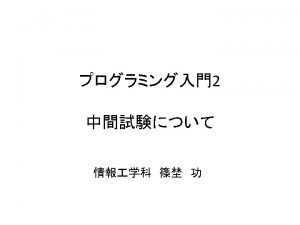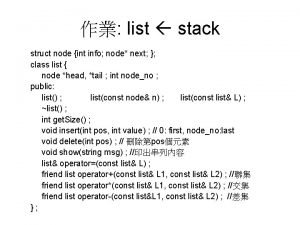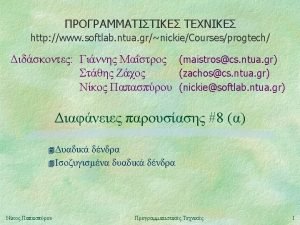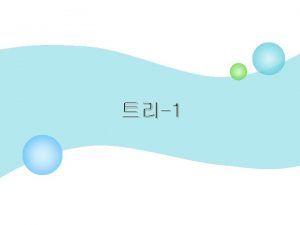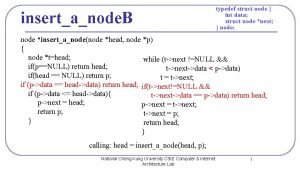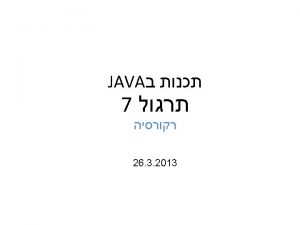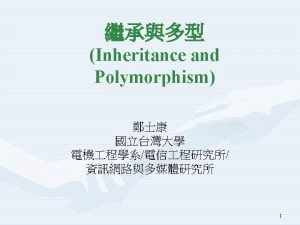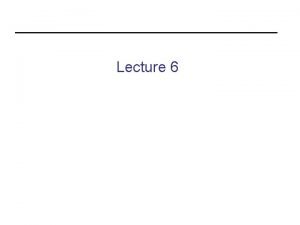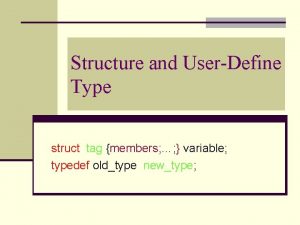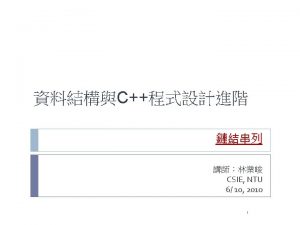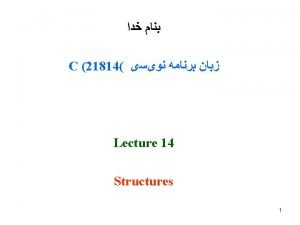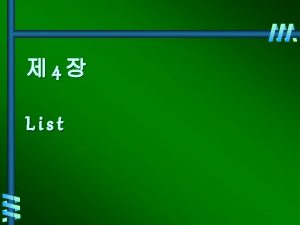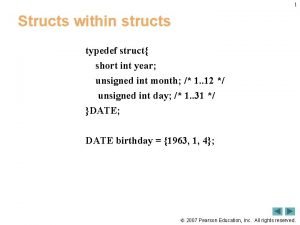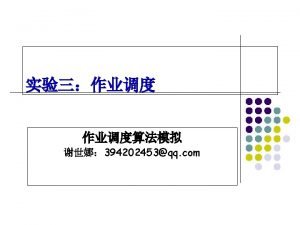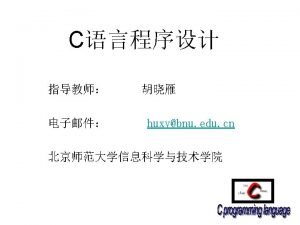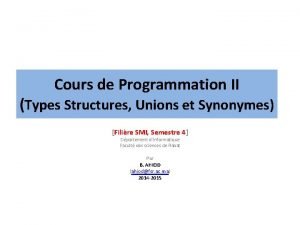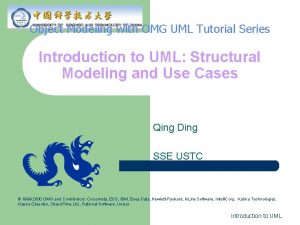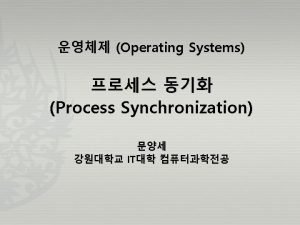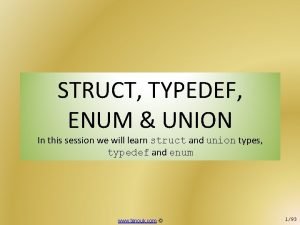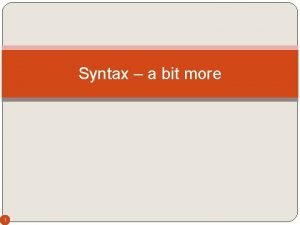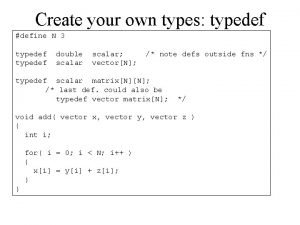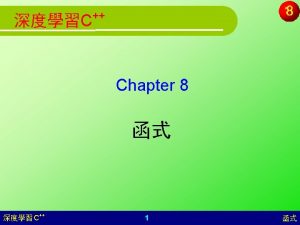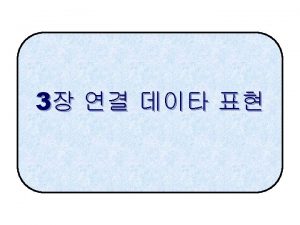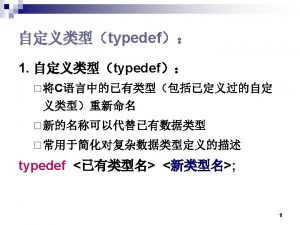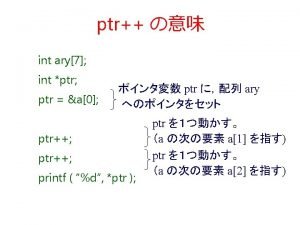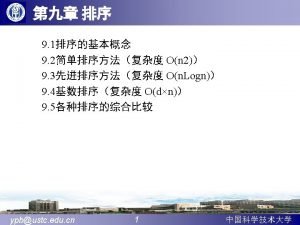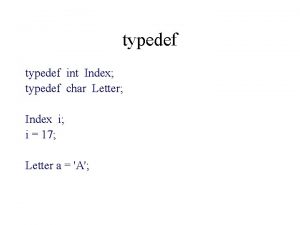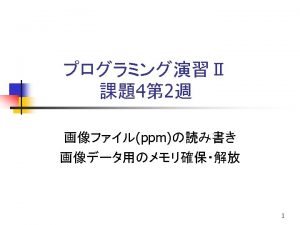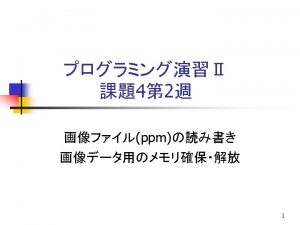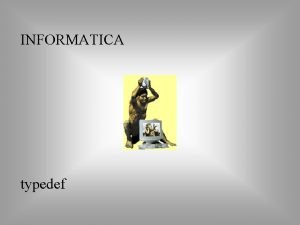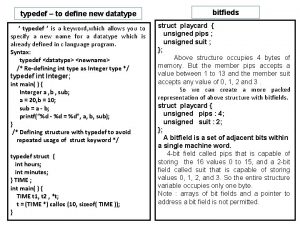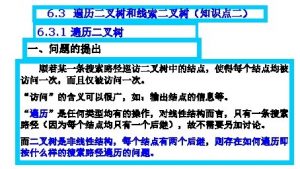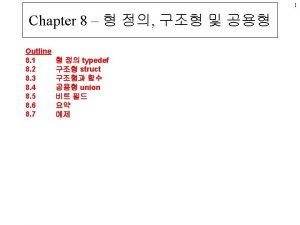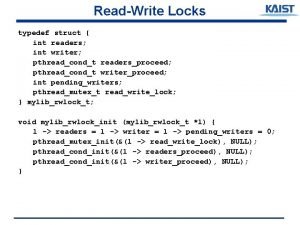typedef int Int A10 Int A a Int












![定义数组类型 typedef int Int. A[10]; Int. A a; Int. A b[5]; Int. A *ap; 定义数组类型 typedef int Int. A[10]; Int. A a; Int. A b[5]; Int. A *ap;](https://slidetodoc.com/presentation_image_h2/4867ee1b3d965f7f990919395606aa7a/image-13.jpg)









![多级指针程序解析 程序 char *c[] = {"ENTER", "NEW", "POINT", "FIRST"}; char **cp[]= {c+3, c+2, c+1, 多级指针程序解析 程序 char *c[] = {"ENTER", "NEW", "POINT", "FIRST"}; char **cp[]= {c+3, c+2, c+1,](https://slidetodoc.com/presentation_image_h2/4867ee1b3d965f7f990919395606aa7a/image-23.jpg)
![多级指针程序解析 char *c[] = {"ENTER", "NEW", "POINT", "FIRST"}; char **cp[]= {c+3, c+2, c+1, c}; 多级指针程序解析 char *c[] = {"ENTER", "NEW", "POINT", "FIRST"}; char **cp[]= {c+3, c+2, c+1, c};](https://slidetodoc.com/presentation_image_h2/4867ee1b3d965f7f990919395606aa7a/image-24.jpg)






![行指针(数组指针)[续] #include <stdio. h> #include <string. h> char (*defy(char *p))[5] { int i; for(i=0; 行指针(数组指针)[续] #include <stdio. h> #include <string. h> char (*defy(char *p))[5] { int i; for(i=0;](https://slidetodoc.com/presentation_image_h2/4867ee1b3d965f7f990919395606aa7a/image-31.jpg)

![如何更清晰地定义函数defy � � 函数defy的返回值是一个行指针, 基类型是:长度为 5的字符数组 利用typedef命令,程序更清晰 typedef char CA 5[5]; CA 5 *defy(char 如何更清晰地定义函数defy � � 函数defy的返回值是一个行指针, 基类型是:长度为 5的字符数组 利用typedef命令,程序更清晰 typedef char CA 5[5]; CA 5 *defy(char](https://slidetodoc.com/presentation_image_h2/4867ee1b3d965f7f990919395606aa7a/image-33.jpg)




- Slides: 37












![定义数组类型 typedef int Int A10 Int A a Int A b5 Int A ap 定义数组类型 typedef int Int. A[10]; Int. A a; Int. A b[5]; Int. A *ap;](https://slidetodoc.com/presentation_image_h2/4867ee1b3d965f7f990919395606aa7a/image-13.jpg)
定义数组类型 typedef int Int. A[10]; Int. A a; Int. A b[5]; Int. A *ap; 定义了一个行指针 等价于: int a[10]; int b[5][10]; int (*ap)[10]; 13

自定义类型-typedef语句 typedef 原类型名 新类型; � � � typdef double Real; typdef char Byte; typdef int *Pointer; � � � Pointer p int * p; Pointer *q int **q; 定义了一个二级指针 typdef int Array[10]; � � Array a int a[10]; Array *p int (*p)[10]; 定义了一个面指针 14

Typedef常用语结构类型 使用方便 � struct _POINT { float x, y; }; typedef struct _POINT; � � � typedef struct { float x, y } POINT; � � POINT p 1, p 2; struct _POINT p 1, p 2; POINT *p struct _POINT *p; 无名结构 如果结构成员多,一般写成多行 typedef struct { float x; float y; } POINT; 15

typedef多个新类型 � typedef struct { float x; float y; } POINT, * PPOINT; 定义了两个新的数据类型:POINT和PPOINT x; x是什么类型? 16

typedef命令语法格式 类似于定义变量 � double Real; typedef double Real; � � � double *PReal; typedef double *PReal; struct _Point; typdef struct _Point; � � Array a; int a[10]; int * PArray[20]; typedef int *PArray[20]; � � � Point p; struct _Point p; int Array[10]; typedef int Array[10]; � � Real x; double x; 这是指针数组 PArray p; int *p[20]; int (*AP)[30]; typedef int (*AP)[30]; � � 只是行指针 AP p; int (*p)[30]; 17





![多级指针程序解析 程序 char c ENTER NEW POINT FIRST char cp c3 c2 c1 多级指针程序解析 程序 char *c[] = {"ENTER", "NEW", "POINT", "FIRST"}; char **cp[]= {c+3, c+2, c+1,](https://slidetodoc.com/presentation_image_h2/4867ee1b3d965f7f990919395606aa7a/image-23.jpg)
多级指针程序解析 程序 char *c[] = {"ENTER", "NEW", "POINT", "FIRST"}; char **cp[]= {c+3, c+2, c+1, c}; char ***cpp = cp; main() { printf("%s", **++cpp); printf("%s", *--*++cpp); printf("%s", *cpp[-2]+3); printf("%sn", cpp[-1]+1); }
![多级指针程序解析 char c ENTER NEW POINT FIRST char cp c3 c2 c1 c 多级指针程序解析 char *c[] = {"ENTER", "NEW", "POINT", "FIRST"}; char **cp[]= {c+3, c+2, c+1, c};](https://slidetodoc.com/presentation_image_h2/4867ee1b3d965f7f990919395606aa7a/image-24.jpg)
多级指针程序解析 char *c[] = {"ENTER", "NEW", "POINT", "FIRST"}; char **cp[]= {c+3, c+2, c+1, c}; char ***cpp = cp; 示意图: ccp cp cp[0] cp[1] cp[2] cp[3] c c[0] c[1] c[2] c[3] “ENTER ” “NEW” “POINT ” “FIRST ”






![行指针数组指针续 include stdio h include string h char defychar p5 int i fori0 行指针(数组指针)[续] #include <stdio. h> #include <string. h> char (*defy(char *p))[5] { int i; for(i=0;](https://slidetodoc.com/presentation_image_h2/4867ee1b3d965f7f990919395606aa7a/image-31.jpg)
行指针(数组指针)[续] #include <stdio. h> #include <string. h> char (*defy(char *p))[5] { int i; for(i=0; i<3; i++) p[strlen(p)] = 'A'; return (char(*)[5])p+1; } void main() { char a[] = "FROGØSEALØLIONØLAMB"; puts( defy(a)[1]+2 ); } 31

![如何更清晰地定义函数defy 函数defy的返回值是一个行指针 基类型是长度为 5的字符数组 利用typedef命令程序更清晰 typedef char CA 55 CA 5 defychar 如何更清晰地定义函数defy � � 函数defy的返回值是一个行指针, 基类型是:长度为 5的字符数组 利用typedef命令,程序更清晰 typedef char CA 5[5]; CA 5 *defy(char](https://slidetodoc.com/presentation_image_h2/4867ee1b3d965f7f990919395606aa7a/image-33.jpg)
如何更清晰地定义函数defy � � 函数defy的返回值是一个行指针, 基类型是:长度为 5的字符数组 利用typedef命令,程序更清晰 typedef char CA 5[5]; CA 5 *defy(char *p) { int i; for(i=0; i<3; i++) p[strlen(p)] = 'A'; return (CA 5*)p+1; } char (*defy(char *p))[5] { int i; for(i=0; i<3; i++) p[strlen(p)] = 'A'; return (char(*)[5])p+1; }




 Sum0
Sum0 Ansi a10.14
Ansi a10.14 Struct node *next
Struct node *next Typedef struct tree int info struct *left
Typedef struct tree int info struct *left Typedef int
Typedef int Typedef struct tree int info struct *left
Typedef struct tree int info struct *left Typedef struct node
Typedef struct node Typedef struct node
Typedef struct node Typedef struct tree int info
Typedef struct tree int info Divideint
Divideint Int max(int x int y)
Int max(int x int y) Inheritance calculator
Inheritance calculator Public void drawsquare(int x, int y, int len)
Public void drawsquare(int x, int y, int len) Typedef struct tag
Typedef struct tag 생능출판사 교수 아이디
생능출판사 교수 아이디 Typedef struct node
Typedef struct node Type
Type Typedef list
Typedef list Typedef struct en c
Typedef struct en c Typedef struct node
Typedef struct node Typedef struct c
Typedef struct c Typedef
Typedef H
H Typedef float
Typedef float Uml
Uml Typedef struct
Typedef struct Typedef union
Typedef union Forward declaration of typedef
Forward declaration of typedef Typedef bool
Typedef bool C typedef enum
C typedef enum Typedef
Typedef Int max
Int max Int main int argc char argv
Int main int argc char argv Int main() int num=4
Int main() int num=4 Mainint
Mainint Void swap
Void swap Int factorial(int n)
Int factorial(int n)
